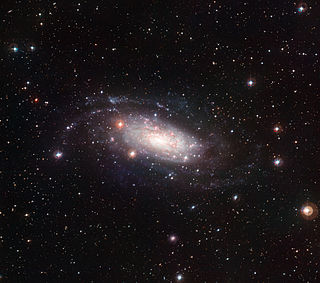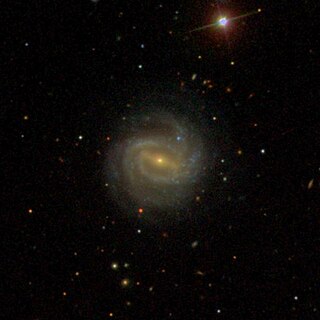
Messier 61 is an intermediate barred spiral galaxy in the Virgo Cluster of galaxies. It was first discovered by Barnaba Oriani on May 5, 1779, six days before Charles Messier discovered the same galaxy. Messier had observed it on the same night as Oriani but had mistaken it for a comet. Its distance has been estimated to be 45.61 million light years from the Milky Way Galaxy. It is a member of the M61 Group of galaxies, which is a member of the Virgo II Groups, a series of galaxies and galaxy clusters strung out from the southern edge of the Virgo Supercluster.

NGC 3504 is a barred spiral galaxy in the constellation Leo Minor. It has a Hubble distance corresponding to 88 million light-years and was discovered by William Herschel in 1785.

NGC 3621 is a field spiral galaxy about 22 Mly (6.7 Mpc) away in the equatorial constellation of Hydra. It is comparatively bright and can be well seen in moderate-sized telescopes. The galaxy is around 93,000 ly (29,000 pc) across and is inclined at an angle of 66° from being viewed face on. It shines with a luminosity equal to 13 billion times that of the Sun. The morphological classification is SA(s)d, which indicates this is an ordinary spiral with loosely wound arms. There is no evidence for a bulge. Although it appears to be isolated, NGC 3621 belongs to the Leo spur.

NGC 3447 is a barred Magellanic spiral galaxy located in the constellation Leo. Its speed relative to the cosmic microwave background is 1,405 ± 34 km/s, which corresponds to a Hubble distance of 20.7 ± 1.5 Mpc. It was discovered by the British astronomer John Herschel in 1836.

NGC 5377 is an intermediate barred spiral galaxy located in the constellation Canes Venatici. Its speed relative to the cosmic microwave background is 1,951 ± 11 km/s, which corresponds to a Hubble distance of 28.8 ± 2.0 Mpc. NGC 5377 was discovered by German-British astronomer William Herschel in 1787.

NGC 1620 is an intermediate spiral galaxy in the constellation of Eridanus. Its velocity with respect to the cosmic microwave background is 3,455 ± 4 km/s, which corresponds to a Hubble distance of 51.0 ± 3.6 Mpc Mpc. It was discovered by German-British astronomer William Herschel on 1 January 1786.

NGC 6008 is a barred spiral galaxy in the constellation of Serpens. Its velocity with respect to the cosmic microwave background is 4,959 ± 8 km/s, which corresponds to a Hubble distance of 73.2 ± 5.1 Mpc. It was discovered by French astronomer Édouard Stephan on 10 June 1880.

NGC 5419 is a large elliptical galaxy in the constellation of Centaurus. Its velocity with respect to the cosmic microwave background is 4,375 ± 23 km/s, which corresponds to a Hubble distance of 64.5 ± 4.5 Mpc. It was discovered by British astronomer John Herschel on 1 May 1834.

NGC 1642 is a spiral galaxy in the constellation of Taurus. Its velocity with respect to the cosmic microwave background is 4,575 ± 3 km/s, which corresponds to a Hubble distance of 67.5 ± 4.7 Mpc. It was discovered by German astronomer Heinrich d'Arrest on 29 December 1861.

NGC 1511 is a barred spiral galaxy in the constellation of Hydrus. Its velocity with respect to the cosmic microwave background is 1341 ± 5 km/s, which corresponds to a Hubble distance of 19.76 ± 1.39 Mpc. It was discovered by British astronomer John Herschel on 2 November 1834.

NGC 3443 is a spiral galaxy in the constellation of Leo. Its velocity with respect to the cosmic microwave background is 1468 ± 24 km/s, which corresponds to a Hubble distance of 21.66 ± 1.56 Mpc. It was discovered by American astronomer Lewis Swift on April 24, 1887.

NGC 2528 is an intermediate spiral galaxy in the constellation of Lynx. Its velocity with respect to the cosmic microwave background is 4098 ± 12 km/s, which corresponds to a Hubble distance of 60.45 ± 4.23 Mpc. It was discovered by French astronomer Édouard Stephan on 22 January 1877.

NGC 1590 is a spiral galaxy in the constellation of Taurus. Its velocity with respect to the cosmic microwave background is 3826 ± 8 km/s, which corresponds to a Hubble distance of 56.43 ± 3.95 Mpc. It was discovered by German astronomer Heinrich d'Arrest on 28 October 1865.

NGC 1086 is a spiral galaxy in the constellation of Perseus. Its velocity with respect to the cosmic microwave background is 3848 ± 14 km/s, which corresponds to a Hubble distance of 56.76 ± 3.98 Mpc. It was discovered by American astronomer Lewis Swift on 20 August 1885.

NGC 3087 is an elliptical galaxy in the constellation of Antlia. Its velocity with respect to the cosmic microwave background is 2987 ± 30 km/s, which corresponds to a Hubble distance of 44.05 ± 3.13 Mpc. It was discovered by British astronomer John Herschel on 2 February 1835.

NGC 2708 is a spiral galaxy in the constellation of Hydra. Its velocity with respect to the cosmic microwave background is 2315 ± 22 km/s, which corresponds to a Hubble distance of 34.15 ± 2.41 Mpc. It was discovered by German-British astronomer William Herschel on 6 January 1785. This galaxy was also observed by British astronomer John Herschel on 12 March 1826, and later listed as NGC 2727.

NGC 4330 is a spiral galaxy in the constellation of Virgo. Its velocity with respect to the cosmic microwave background is 1898 ± 24 km/s, which corresponds to a Hubble distance of 27.99 ± 1.99 Mpc. However, a dozen non-redshift measurements give a distance of 19.642 ± 1.559 Mpc. The galaxy was discovered by Irish engineer Bindon Stoney on 14 April 1852.

NGC 7110 is a barred spiral galaxy in the constellation of Piscis Austrinus. Its velocity with respect to the cosmic microwave background is 5044 ± 20 km/s, which corresponds to a Hubble distance of 74.39 ± 5.22 Mpc. It was discovered by British astronomer John Herschel on 23 September 1834.

NGC 7363 is a barred spiral galaxy in the constellation of Pegasus. Its velocity with respect to the cosmic microwave background is 6393 ± 24 km/s, which corresponds to a Hubble distance of 94.29 ± 6.61 Mpc. It was discovered by German astronomer Heinrich d'Arrest on 27 August 1865.

NGC 3052 is a intermediate spiral galaxy in the constellation of Hydra. Its velocity with respect to the cosmic microwave background is 4122 ± 24 km/s, which corresponds to a Hubble distance of 60.79 ± 4.27 Mpc. However, 19 non redshift measurements give a distance of 42.563 ± 6.434 Mpc. The galaxy was discovered by German-British astronomer William Herschel on 7 February 1785.





















